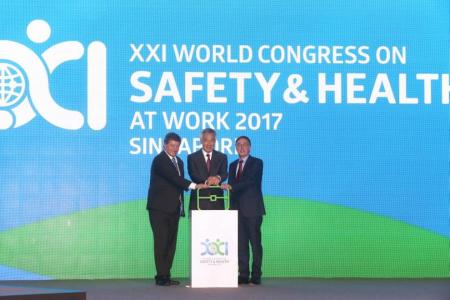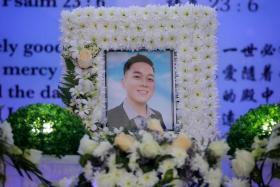New target to reduce workplace fatalities
PM Lee says technology can help companies bring workplace fatality rate to less than one death for every 100,000 workers by 2028
Prime Minister Lee Hsien Loong has set a new target for safety standards in Singapore, even as the current workplace fatality rate of 1.9 deaths for every 100,000 workers has almost met the 2018 target of 1.8 deaths for every 100,000 workers.
The new benchmark is now less than one death for every 100,000 workers by 2028.
Speaking at the official opening of the three-day World Congress on Safety and Health at Work 2017 yesterday, Mr Lee said: "We will have to work hard, but I am confident that we can achieve the new target."
Singapore's efforts on workplace safety and health (WSH) date back more than a decade.
In 2004, the country's workplace fatality rate was five deaths for every 100,000 workers - higher than many developed countries, said Mr Lee.
In 2008, when the rate stood at 2.8, Mr Lee called for it to be pared down to 1.8 deaths for every 100,000 workers within 10 years.
That target was met in 2014, but the rate has crept up to 1.9 in the last two years.
"But this is still not the best that can be achieved... countries like the Netherlands, the UK and Sweden all have workplace fatality rates of less than one for every 100,000 employed persons and there is no reason why Singapore cannot be as good as them," said Mr Lee.
Another country he cited was Finland. In 2002, the Finnish fatality rate stood at 1.8 deaths for every 100,000 workers and by 2013, it was 0.9.
These countries have been successful through a combination of factors, including taking a holistic approach to WSH and continually improving workplace cultures, attitudes and behaviour, experts told The New Paper.
One way Singapore can meet its 2028 target is for companies to embrace technology.
Technology can help reduce human errors that cause workplace accidents, said Mr Lee, citing Lendlease as an example.
The property and infrastructure company uses drones to monitor site activities as well as facial recognition systems to allow only trained workers to access construction sites.
MONITOR
Some transport and logistics companies have also used technology to monitor driving habits, said Mr Lee.
"If the driver is falling asleep, an alert will be triggered. The seat will vibrate and the driver, hopefully, will wake up.
"It will also generate regular reports to study and analyse driving habits, identify poor drivers and send them for retraining," said Mr Lee.
While larger companies already have workplace safety programmes in place, smaller companies may find it difficult to do so, he said.
Thus, the Ministry of Manpower (MOM) will set up a Total WSH Services Centre at Woodlands to advise smaller companies and support them in implementing workplace safety and health programmes.
To encourage companies to innovate and use technology more, MOM will also launch a Workplace Safety and Health Technology Challenge, focusing on vehicular safety for a start.
Traffic accidents are the top cause of workplace fatalities between 2013 and last year, claiming 82 lives.
A $2 million Government fund has been set up to fund research into technologies to reduce the number of workers killed in such accidents.
The fund will cover research in areas such as reducing vehicle blind spots, unsafe driving practices and driver fatigue.
Companies and research institutions will receive up to 70 per cent funding to devise new solutions to reduce such deaths.
The MOM is calling for proposals from today, with submissions coming up in November.
The winning projects will be announced in March.
Said Mr Lee: "These are all avoidable accidents, avoidable fatalities, and if we put our mind to it, we will bring the numbers down.
"Using technology to improve all aspects of our lives, including workplace safety and health, is part of our plans to become a Smart Nation."
Get The New Paper on your phone with the free TNP app. Download from the Apple App Store or Google Play Store now



